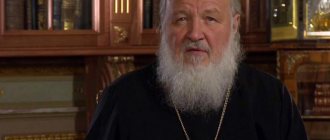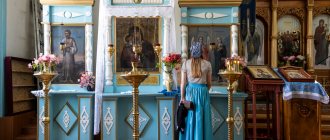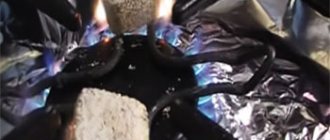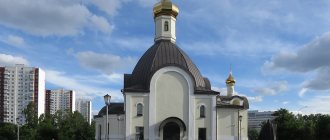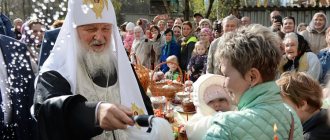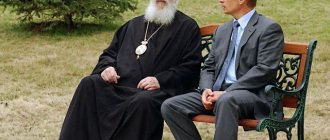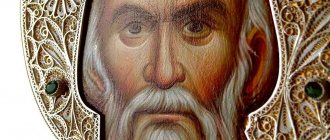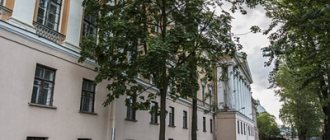HERMANN
(Djoric Hranislav; 19/7.08.1899, Josanicka Banja - 27.08.1991, Belgrade), Patriarch of the Serbian Orthodox Church (SOC) in 1958-1990.
German (Djoric), Patriarch of Serbia. Photo of German (Djoric), Patriarch of Serbia. Photo
Genus. in the family of a teacher, who later took the rank of priest. He studied in Velika Drenovo near Trstenik and in Krusevac, at seminaries in Belgrade and Sremski Karlovtsi (graduated in 1921). He studied law in Paris, then entered the Belgrade Theological Faculty, which he graduated in 1942. In 1924, he was ordained as a deacon at the Žiča Cathedral, and appointed an employee of the ecclesiastical court of the Žiča diocese. From 1925 to 1927 he taught the Law of God at the gymnasium in Cacak. Since 1927 he has been a priest at the parish in Miokovtsi. In 1931 he was transferred to the city of Vrnjacka Banja as rector of the church and bishop's vicar, and established a monthly church at the church. "Pregled" and the annual calendar "St. Lazar".
In 1938, he became a widower and moved to Belgrade, and was appointed referent of the Holy Synod. On June 12, 1951, he was elected chief secretary of the Synod with the rank of bishop with the title “Moravitch”. On July 7, 1951, he was tonsured a monk at the Studenica Monastery, and on July 12, he was elevated to the rank of archimandrite. On July 15, the consecration took place. In 1952, he was elected Bishop of Budim, but could not take the see due to obstacles caused by the Hungarians. by the authorities. From 1956 to 1958 he ruled the Zich diocese, restored more than 40 churches and founded the Jovane Monastery (consecrated on July 7, 1961). In 1955-1956 administrator of the Budimlya-Polim diocese (see Budimlya-Niksic diocese), and in 1956-1957. administrator of the Rasha-Prizren diocese. He was the editor of the main organ of the SOC - Zh. "Glasnik".
13 Sep. 1958 elected Serbian Patriarch. Solving the acute personnel problem of the SOC, G. was the initiator of the election of 27 bishops. Under him, new dioceses were founded: Eastern American and Canadian, Midwestern American and Western American (1963), Western European and Australian (1969), Australian (1973), Vranjska (1975), Canadian (1983), Bihac-Petrovac (1990).
To increase the level of theological education, G. reformed the curricula of theological educational institutions of the SOC, resumed theological seminaries in Sremski Karlovtsi, in the Krka monastery and the monastic school in the Decani monastery. The Orthodox People's University was founded in the building of the Patriarchate in Belgrade, in which G. gave lectures, many of which were later published. In the Patriarchate of Georgia, the publishing activities of the SOC were expanded, and gas was established. "Orthodoxy", w. “Teoloshki Pogledi” (Theological Review), edition in English. language “Serbian Orthodox Church, Its Past and Present” (Serbian Orthodox Church, its past and present), children's f. “Svetosavsko zvontse” (Bell of St. Sava). To support educational and publishing programs, the “Church Charitable Trusteeship” was created. The leitmotif of G.'s numerous sermons and speeches was the idea that “without God within themselves, people ceased to be people.”
G., despite the obstacles of the communist authorities, had special care for the restoration of churches and Mont-Rei. On his initiative, the c. St. Lazarus of Kosovo in Velika Drenovo (1962), monastery of St. Stefan Dečanski in Slanci near Belgrade, chapel of the monastery. Paraskeva Fridays in the Rakovitsa Monastery (1971), c. St. John the Baptist in the central cemetery of Belgrade (1977), c. Saints Equal-to-the-Apostles Constantine and Helena in Belgrade (1971), 26 churches of the Belgrade-Karlovac Archdiocese were restored or reconstructed, in 1984 construction of the memorial church of St. Savva Serbsky on Vracar in Belgrade. To support the Hilandar Monastery, a special account was opened in the Church Charitable Fund of the SOC.
In 1969, in the Patriarchate of Georgia, the 750th anniversary of the autocephaly of the SOC was solemnly celebrated, in 1970 - the 50th anniversary of the restoration of the Pec Patriarchate, in 1971 - the 300th anniversary of the repose of St. Vasily Ostrozhsky, in 1986 - the 800th anniversary of the most ancient Serbian. monastery of Studenica, in 1989 - the 600th anniversary of the Battle of Kosovo. In addition to solemn services, the anniversaries were accompanied by scientific seminars, the publication of books and articles covering the history of the SOC.
In 1964, bishop. The American-Canadian Dionysius (Milivojević) broke off relations with the SOC and founded the Novogracanica diocese; on June 19, 1967, in Ohrid, with the support of the Yugoslav authorities, it was announced that the dioceses located on the territory of the Republic of Macedonia would be united into an independent Macedonian Orthodox Church. To overcome the splits of G. several. once convened the Holy Synod and the Council of Bishops of the SOC, held a number of meetings and consultations with representatives of the Orthodox Churches, but the first schism was overcome only after the death of G., in February. 1992, and the second, with the support of the Macedonian authorities, continues to this day.
G. paid special attention to the development of external church relations of the SOC: he often met with the heads of the Polish, Alexandrian, Antiochian, Jerusalem, Greek, Bulgarian, Romanian, Cypriot, Finnish Orthodox Churches, as well as with the Archbishop of Canterbury. Several times G. was a guest of the Russian Orthodox Church: when visiting Moscow in October. 1961 was elected honorary member of the MDA; in 1963 he took part in celebrations in honor of the 50th anniversary of the episcopal service of Patriarch Alexy I of Moscow and All Rus', in the summer of 1968 - in the celebration of the 50th anniversary of the restoration of the Patriarchate of the Russian Orthodox Church; when visiting on Oct. 1974 Leningrad was elected an honorary member of the LDA.
30 Nov In 1990, due to his advanced age and severe injury, G. was retired. Buried in the center. ap. Mark in Belgrade.
Lit.: Historical luminosity in Peka: Ustoliche Jegove of the Lordship of the Patriarch of the Srpska, Mr. Herman, in the Pekskoj Patrijarshi, May 29, 1960 // Glasnik Srpske Pravosl. Tsrkve. 1960. pp. 134-186; Kashiћ D. Historical significance of the Srpsk Church: The candle was given to Jehovah the Lordship of the Patriarch of the Srpsk Mister Herman at Peka // Vesnik: List of saves of the friendly Orthodox clergy. Beograd, 1960. No. 12; Patriarch of the Srpska Herman: Spomenitsa on the occasion of two decades of serving Jehovah Patrijarashkog, 1958-1978: Sat. Art. Beograd, 1978; Anthony (Pantelic), priest. History of the Serbian Orthodox Church. Churches from 1945 to 1995: Cand. dis. / MDA. Serg. P., 1996. RKP. pp. 64-73.
Archim. Anthony (Pantelic), O. A. Kuzevanov
Patriarch [edit]
Appointment controversy[edit]
When Patriarch Vincent II died suddenly on July 5, 1958, the church leadership was beset by internal strife and no agreement could be reached on who would succeed him. The German was not even appointed as guardian of the throne
(the current patriarch), instead of the bishop of Braničevo, Hrizostom Vojinović was appointed to leave the post. It is believed that Herman's election was a compromise, but the story is still popular that Aleksandar Ranković, a high-ranking Serbian communist at the time and later Josip Broz Tito's deputy, attended a meeting of the Holy Synod, drawing Herman inside and saying: "This is your new Patriarch!
Herman was elected as the 43rd Patriarch of Peche on September 14, 1958. However, some sources claim many more people, as more than a dozen people occupied the throne but were not officially ordained or recognized as such (for example, several rebel patriarchs in the 16th century during the Ottoman occupation) or the Patriarchs of Karlovtsi in Austria-Hungary, which are not included to the list of official patriarchs (especially not as Patriarchs of Pece, calling themselves Patriarchs of the Serbs instead).
Schisms[edit]
Like most Orthodox churches in the Eastern Bloc, the Serbian Orthodox Church under German rule was forced into the treaty
with the ruling Communist League to gain the space needed to operate. Diaspora priests, led by the fiercely anti-communist Bishop Dionysius, said that the "red priests" of Belgrade had caved in too soon. [3] After the Holy Synod began a trial against Dionysius on charges related to his personal life, he entered into a schism with the church in November 1963. [4] Beginning in 1977, the group took the name "Free Serbian Orthodox Church". It was agreed to by the SOC in 1992 under Germany's successor, Paul. [5]
The schism of the Macedonian Orthodox Church is a much deeper and more complex problem. It began in 1958, the year of Germany's election, with the supposedly voluntary acceptance of the autonomy of the Ohrid Archbishopric, proclaimed by Archbishop Dositej. This was a big blow to Germany's religious authority, as it was a forced recognition by the Communist Party. Over the next 9 years, the patriarch and archbishop held several joint liturgies, even with the heads of other Orthodox Churches. However, in 1967, Archbishop Dositej completely separated his archbishopric (within the borders of SR Macedonia) from the mother church, claiming inheritance from the historical church Archbishopric of Ohrid, which had not existed for 200 years. The German and Serbian Orthodox Churches, claiming that the division was forced and uncanonical (in other words, they considered it a church founded by communists), ceased all canonical communion with the Macedonian Orthodox Church. In turn, all other Orthodox Churches followed Herman’s example, as they do to this day. The problem persisted after Germany and the collapse of Yugoslavia, and it became a highly political problem not only for the Serbian Orthodox Church, but also for the Church of Greece and the Bulgarian Orthodox Church.
Revival and aftermath[edit]
Tomb of Patriarch Herman of Serbia in Belgrade's St. Mark's Church
German authorities revived the Serbian Orthodox Church, which (like other religious communities in Yugoslavia) did not receive state support. Throughout his tenure, he behaved with restraint, while achieving certain goals in this direction. Despite the harsh conditions, he managed to form several new dioceses: Western European (1969), Australia (1973), Vranje (1975) and Canada (1983).
He supervised the finishing work of the new complex of seminary buildings in Belgrade (including the university campus) in 1958, so today the entire area surrounding the complex is known as Bogosloviya (the Serbian name for the seminary
).
He also opened a new seminary at the Krka Monastery in Croatia. He was very involved in the appointment of bishops, staunchly resisting his own candidates, especially in the case of the Metropolitanate of Montenegro and Littoral after the communists arrested Metropolitan Arsenij Bradvarević in 1954, but the German managed to appoint his protégé, Danilo Dajković in 1961 [ citation needed
].
He also sent many priests to SR Montenegro, since spiritual activity there had almost completely ceased after the war [ citation needed
].
In 1984, Herman visited the site of the Jasenovac concentration camp, uttering the famous phrase: "To forgive, we must... forget, we must not" (Oprostiti Moramo, zaboraviti ne smomo). [6]
Many consider Herman's greatest achievement to be his successful campaign to resume construction of the Church of St. Sava in Belgrade, which had been stopped in 1941. In the 26 years after his appointment, he called on the communist government 88 times until they finally authorized construction. Construction will continue in 1984. This is a massive project that took a long time to complete and the church was completed in 2021.
Patriarch Herman was a pragmatic religious leader in a time when religion was violent. After Josip Broz Tito's death in 1980, he slowly promoted church issues as Yugoslav society changed and nationalism grew among various peoples, and he eventually became universally popular among Serbs and became part of the Serbian social elite.
In 1989, Patriarch Herman broke his hip, which resulted in a series of operations and repeated injuries, so the old patriarch was unable to fulfill his duties. As a result, the Holy Synod declared him incompetent on November 30, 1990, appointed Metropolitan Bishop of Zagreb and Ljubljana Jovan Pavlović as custodian of the throne and elected the new Patriarch Paul on December 1, 1990 as Patriarch. Herman died at the VMA Hospital in Belgrade on 27 August 1991, aged 92, and was buried in Belgrade's St. Mark's Church.
His 32 years as president are among the longest in the history of the Serbian Orthodox Church.
He was awarded the Order of Saint Sava, [7] the Order of the Yugoslav Flag, the Legion of Honour, the Order of George I, the National Order of the Cedar and a number of other awards and decorations. [8]
Bibliography[edit]
| Wikimedia Commons has media related to German Coric . |
- Vukovic, Sava (1996). Srpski jearsi od devetog do dvadesetog centuries (Serbian hierarchs of the 9th - 20th centuries)
. Euro, Unirex, Kalenic. - Serbian historical church at the Orthodox Research Institute
- Ko je ko u Jugoslaviji 1970
; Chronometar, Belgrade - Srpska porodična enciklopedija
, Vol. VI (2006); People's Book and Politics of NM; ISBN 86-331-2933-7 (NK) - Malaya Prosvetina Encyclopedia
, Third Edition (1985); Clearance; ISBN 86-07-00001-2
Links[edit]
- Serbian Orthodox Church, history. Archived April 18, 2009, in the Wayback Machine at spc.rs.
- Vukovic 1996, p. 133.
- Hawkenos, Paul (2003). A Call to the Motherland: Patriotism in Exile and the Balkan Wars
. Cornell University Press. pp. 121–122. ISBN 978-0-8014-4158-5. - Spasovich, Stanimir; Miletic, Srbolyub. “THE HISTORY OF THE SRPSK ORTHODOX CHURCH IN AUSTRALIA, NEW ZEALAND AND SOUTH AFRICA—THE INDUSTRY OF THE SCHIPT ON THE NORTH AMERICAN CONTINENT.” svetosavlje.org
(in Serbian). Archived from the original on September 24, 2015. Retrieved April 23, 2021. - Puzovic, Predrag (1996). “Dioceses of the Srpska Orthodox Church in the Race” (PDF). Theology: Book of Hours of the Orthodox Theological Faculty at Beograd
(in Serbian).
40
(1–2): 87–96. - Administrator. “FIGHT FOR FAITH - Orthodox Christians put a premium on non-Orthodox phrases” forgive Moramo, don’t dare. borbazaveru.info
. - Acović, Dragomir (2012). Glory and part: Odlikovanja među Srbima, Srbi među odlikovanjima
. Belgrade: Sluzbeni Glasnik. paragraph 97. - Acović, Dragomir (2012). Glory and part: Odlikovanja među Srbima, Srbi među odlikovanjima
. Belgrade: Sluzbeni Glasnik. pp. 324–329.
